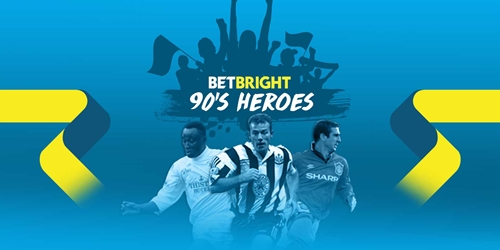’90s Heroes is a new series by Adam Hurrey on the Bet Bright football blog which looks back on the legends of the game in what now seems a simpler time for football.
“If one wishes to remain inconspicuous, it is not advisable to drive through a bus station after midnight, having ignored a “no entry” sign. This is particularly true if you happen to be the centre-forward for one of the city’s two professional football teams, and someone valued at many millions of pounds” – Alan Pattullo, In Search of Duncan Ferguson.
A quick scan through the forward lines of Premier League clubs for the 2016/17 season suggests one British footballing tradition – for better or worse – is on the verge of extinction. There is still just about a place for a physical presence up front – be it the deluxe nuisance of Diego Costa, the intermittent bombast of Andy Carroll, or the semi-retired Peter Crouch – but they are all pale imitations of an outdated concept: the old-fashioned number nine.
Before the Premier League was (literally) overrun by attacking whippets and pocket dynamos, it seemed there would always be a home in British football for what would understatedly be called “a handful”. It may have been of no long-term benefit for our national teams’ prospects, but we took a genuine thrill in seeing the ball arrowing towards the head of a no-nonsense centre-forward. In the formidable shape of Duncan Cowan Ferguson (goals: 68, red cards: 8, nonsense: below zero) we may not have realised that we were enjoying one of the last of them.
There is some mystery to Big Dunc, but not much of it was to be found on the football pitch, where he was acutely aware of his primary weapon. A headbutt planted on Raith Rovers’ Jock McStay at Ibrox in 1994 led to a 44-day stint in HMP Barlinnie the following year. Of the top 50 or so all-time Premier League goalscorers, nobody has relied on their head (53%) more than him. Ferguson is the only player in Premier League history to score a hat-trick of headers. The man was very probably born in the mixer.
Ferguson’s first goal in English football perhaps summed him up better than any other. It wasn’t just his towering above the Liverpool defence at Goodison Park one Monday night in 1994. It wasn’t just the sheer panic within that six-yard box caused by the combination of a inswinging corner and one of the scariest men ever to play football. 48 (possibly embellished ) hours earlier, he had been five bottles of red wine to the good – “It was quite funny – well, it was not funny – I had been out on the lash, know what I mean?” – and ended up in a cell, being sobered up by some Evertonian police officers with only a Merseyside derby on their minds.
Safely back in his hotel room the next morning, Ferguson regathered his senses for the match – Everton manager Joe Royle’s first in charge. Neil Ruddock – the perfect catalyst for any mid-90s footballing firestorm – introduced himself with a scything challenge from behind. It was, in 2016 parlance, lit. Soon after, Ferguson rose above Ruddock – and David James, John Scales, everyone – to use his trusty head and send the blue half of Liverpool berserk.
If it wasn’t broke, Ferguson wasn’t likely to fix it. His eight goals in the 1994/95 season were a showcase in barnstorming headers (including a physics-defying leap and his first of five headed goals against United, another Premier League record) or larruping left-foot finishes. Unlike other notable beanpoles, Ferguson knew how best to manoeuvre his 6ft 4in frame inside the penalty area.
Choreographed goal celebrations, unsurprisingly, weren’t Ferguson’s thing – unless he was deliberately marking each of his devastating finishes like a man being dragged away against his will from a pub brawl – save for the odd look of “what are you going to do about it?” to any brave opposition fans who voiced their disapproval.
A reluctant £8m move to Ruud Gullit’s chaotic Newcastle lasted less than two years, but there were still glimpses of Duncan at his most Disorderly – a 3-0 win over Manchester United at St James’ Park was sparked into life when Ferguson tramped all over Jaap Stam and, soon after, swivelled to lash a 25-yarder into the top corner. Duncan Ferguson did not do subtle.
They say to never go back, which sounds like the sort of thing Duncan Ferguson would happily ignore, and so he returned to Goodison and to the Everton fans who adored him. The goals flowed rather less freely this time, but the retro ultraviolence was undimmed. His victims included Leicester’s Steffen Freund – the strangling of whom earned a four-match ban – and no fewer than three burglars to his Lancashire home, who may have been bemoaning their choice of target ever since.
Duncan 'The Gentle Giant' Ferguson. RT @HewyinSydney "@OldSchoolPanini the only good pic of Freund pic.twitter.com/BlYMflAhZx"
— Lee Mc (@L33McMillan) January 19, 2015
By his snarling mid-30s, Ferguson had become cast as the ultimate impact sub for Everton – he gave opposing defences something to worry about from the bench no fewer than 29 times in 2004/05. For any other striker with such obvious goalscoring threat, it would be tempting to wonder what could have been – especially given an international career that barely got going after a falling-out with the Scottish FA.
For Duncan Ferguson, though – the only player to have received a Premier League red card on Valentine’s Day – he retired to Majorca with barely a word, leaving a passable highlights reel, a chequered backstory and a footballing legacy as perhaps the last genuinely terrifying Premier League striker to play against.
For the next instalment of ’90s Heroes, check out the Bet Bright football blog on Friday.







